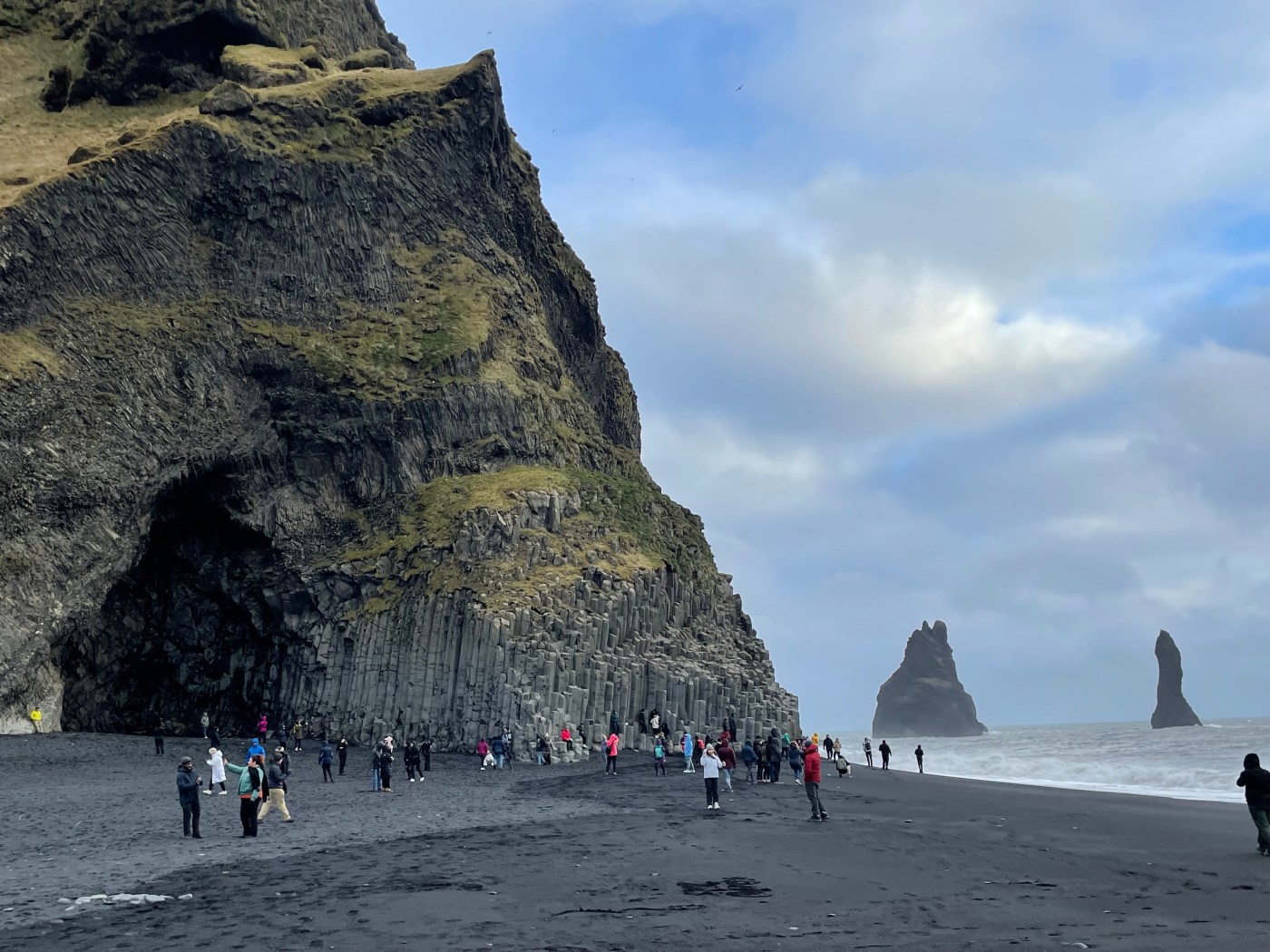
The northern lights were scarce, but trip to Iceland was fantastic anyway
Last summer, I woke to the sounds of my family oohing and aahing as they watched the northern lights dance across a lake in Wisconsin. I had never seen this atmospheric phenomenon before, so I ran down to the dock and looked over the water. The sky was so vibrant green that I felt like Dorothy in the Wizard of Oz looking out at the Emerald City. It was magical. I was so excited that I shared my photos with everyone.
My neighbor made a print of the picture on canvas so I could look at the lights all summer. My sister’s boyfriend gave me a coffee cup for Christmas that lights up with the northern lights when hot coffee gets poured into it. Needless to say, I was hooked, so traveling over the rainbow to Iceland to get a closer look was no surprise to anyone.
Iceland Bound
The northern lights, as viewed from Iceland. (Lori Swanson / Pioneer Press)
My travel group consisted of two girlfriends and my sister, all on the same quest to see the northern lights in all their vibrant glory. We were so excited that we made reservations to see the lights the first night we got to Reykjavik. We caught the bus at 10 p.m. and drove 45 minutes to a dark location with no city lights. Hundreds of travelers had the same idea, so 300 heads peered at the dark sky in hopes of seeing dancing bursts of color. We waited and waited and waited … finally, there was a faint green spot in the sky (actually you could only see it through your camera lens). Shortly thereafter, it was time to leave. The good news is that if you book a northern lights tour and you get skunked, you can rebook it for another night. We still had high hopes.
Iceland is a small country with the majority of the population living in the town of Reykjavik. Much of the dramatic landscape beyond Reykjavik is defined by stout Icelandic horses, volcanoes, erupting geysers, hot springs, and lava fields. Earthquakes are common in Iceland, and although a few took place during our visit — including one that was over 3 on the Richter scale — we didn’t feel any of them. Iceland has many volcanic systems currently considered active, with the last one erupting in July 2023, only 19 miles from Reykjavik.
The tour we booked was with a hotel and consisted of breakfast every morning, buses for tours and transfers to and from the hotel/airport. Reykjavik is easy to walk around in, and Iceland has been crowned the safest country in the world for the past 14 years in a row by the Global Peace Index. We were never worried about walking, day or night. The cost of our tour with the air fare was just under $2,000 apiece (not including riding Icelandic horses).
Blue Lagoon
The Blue Lagoon in Iceland. (Lori Swanson / Pioneer Press)
The Blue Lagoon, another can’t-miss attraction, is a spectacular geothermal spa where lava and thermal water meet, and the outcome is superb. The warm water and natural active ingredients (mineral salts, silica, and blue-green algae) are a perfect mixture of relaxing and cleansing. We upgraded our package to get robes and additional mask treatments. The Blue Lagoon’s white silica mud gently cleanses and exfoliates the skin.
While it’s a great facial treatment, the look of the white masks while hardening is hysterical – everyone is floating around the pool looking like Michael Myers in the Halloween movie. If it wasn’t so relaxing, it could be frightening. The Blue Lagoon also has a swim-up bar that provides guests with a free drink with their entrance package. The pools are huge, and although a lot of people were at the spa, there was plenty of room without feeling cramped or crowded. There are steam rooms and saunas for your use. The best tip we heard was to go there your first day, as they have storage lockers for luggage (we got into Iceland early morning and room check-in isn’t until noon or later). This would have been a great way to unwind from the 6-hour flight.
South Shore adventure
The Skogafoss waterfall in Iceland. (Lori Swanson / Pioneer Press)
To see more of the country, we hopped on a bus and headed for the south shore of Iceland, which is mostly farm landscape with Icelandic horses and sheep roaming in the fields. We had clear skies, so we caught both of the area’s two most famous volcanoes in the distance: Mount Hekla (last eruption in 2000) and Eyjafjallajokull (last eruption in 2010). The plan was to visit waterfalls, a black sand beach, and glaciers while we were there.
The first stop was the Skogafoss Waterfall, which is considered to be one of the largest waterfalls in Iceland. There is a steep staircase that leads to the top of the falls. Although we did not take the stairs, it was easy to get up close to the falls, which drop 197 feet, spraying the bottom with large water droplets from every direction. No one walked away without getting wet – but everyone was smiling ear to ear. While we were there the water drops in the air mixed with sunlight to produce a vivid rainbow. In fact, while taking a photo we noticed we were standing in a full circle rainbow – a first for all of us.
Sólheimajökull Glacier in Iceland. (Lori Swanson / Pioneer Press)
Just a short drive away, we stopped at a small lake formed by Sólheimajökull Glacier. Hikers of all ages were putting metal crampons on their boots and using spiked walking sticks to climb part of the glacier. The glacier is retreating at a fast rate (about the size of an Olympic swimming pool annually), and with climate change could virtually disappear in 100 years or so.
The next stop was the Reynisfjara black sand beach, with its extraordinary rock formations and basalt sea stacks. It is one of the most magnificent beaches in Iceland. While the black sand and rock formations are spectacular, the beach is considered dangerous. Visitors are asked not to turn their backs to the ocean or go more than 3 feet from the water due to “sneaker waves.” These devious rouge waves appear suddenly, surging up the beach and carrying unaware beachgoers into the ocean.
Our final stop of the day was Sejalandsfoss Falls, which has a full circle pathway that stretches around the cascading falls. My sister and I found two heart-shaped rocks, and in honor of our dad and aunt we put their initials on them and threw them into the falls, I knew my dad would be smiling because my throw barely made it into the water. I could hear him say, “Nice job,” and laugh.
The author and her sister throw stones into Sejalandsfoss Falls in Iceland. (Lori Swanson / Pioneer Press)
Northern lights, part 2
On our way back our tour director mentioned that tonight was a go for the aurora borealis. We hopped on another bus and headed out, again, to see the emerald lights dazzle in the pitch-dark sky. The tour manager got everyone excited by telling us even though we couldn’t see the lights, she could, and it promised to be a spectacular night of dancing lights spiraling over our heads.
As we got closer, we could see the light green hue in the sky – this is what we were waiting for. We jumped off the bus and ran to get a prime spot in front of the hundreds of others waiting to see this phenomenon happen before our eyes. I held my camera up to the light green hue and shot a photo – the picture looked much better than the faint green hue I was looking at. Another tour guide told us how lucky we were to be out there and see this, then he turned around and said, I am going to get a hot chocolate. That’s when we knew it was over and this light hue was the best we would get for the night. Skunked again.
Icelandic horses
Both my sister and I own horses and wanted to experience riding the Icelandic horses.
They are the only horse breed allowed in Iceland. If they are exported, they can never return to Iceland.
These stocky, resilient horses (do not call them ponies) have survived volcanic eruptions and harsh ice winters. The horses have unique gaits called the tolt and the skeio. The tolt is a smooth and fast 4-beat gait (at least one foot on the ground at all times). The tolt is useful in helping the horse easily navigate the rocky and uneven terrain of the volcanic landscapes. The skeio is a flying pace (super-fast, lateral gait or both legs on one side touch the ground at the same time) where at some points there are no hooves in contact with the ground. Icelandic horses can reach the speed of 30 miles per hour in the skeio gait – way too fast for me to even think of trying. It seems like everyone in Iceland has had an Icelandic horse at one time or another.
They are very fun horses to ride, but unfortunately, they also raise these beautiful animals for meat.
Northern lights, part 3
Finally, we wised up and put the northern lights app on our phones so we could get up-to-date information on the timing and potential strength of the lights each night. The app showed the number 6, which is a high probability of seeing the lights. Knowing this could be it, we ran from our hotel rooms up to the rooftop. We excitedly saw the green hues in the sky surrounding us — it looked promising, and we didn’t have to take a bus to get there. I took a few photos and again, and while they looked much better than what we saw with our eyes, there was still no Emerald City. I felt we didn’t get skunked, but my fellow travelers thought we did.
Golden Circle
Tomatoes at an indoor farm in Iceland. (Lori Swanson / Pioneer Press)
Every local we talked to said to be sure to do the Golden Circle tour. It was a great tip. We encountered volcanic craters, geothermal pools, geysers, a geothermal farm, and a national park.
We also saw a family-run tomato farm and horse stable called Fridheimar. The farm is home to about 10,000 plants in their hydroponic greenhouses that use low-cost geothermal heating to create Mediterranean-like conditions year-round. The annual harvest is around 370 tons. The tomatoes are picked by hand and pollinated by bumble bees that live within the greenhouse. There is a restaurant and bar right in the greenhouse, serving up anything tomato: soup, jam, pickles, drinks, sauces and even just plain tomatoes. We tried the soup and a coffee tomato drink – all delicious.
We continued to the geothermal fields of geysers, with bubbling mud pools and the high-spouting Strokkur Geyser, which erupts every 4 to 8 minutes, reaching almost 100 feet in the sky. Strokkur is the most active geyser in Iceland. Molten magma has to be close to the surface of the earth to make the rocks hot enough to boil water.
Gullfoss waterfall in Iceland. (Lori Swanson / Pioneer Press)
Lastly, we visited Gullfoss, the king of Iceland’s waterfalls, where tons of icy water flows majestically down double ledges into a deep canyon. Gullfoss consists of two falls – the smaller cascade is 36 feet tall, and the bigger falls rush from 69 feet. There is a two-mile path weaving in and out of different stages of the waterfalls with breathtaking views from all angles.
Our last stop was Thingvellir National Park, a UNESCO World Heritage Site, where the world’s oldest parliament met for centuries on the shores of Iceland’s largest lake. The national park is part of the Atlantic Ocean ridge that runs through Iceland and defines the boundary between the North American and Eurasian tectonic plates. Paths are built through the large erosion cracks that run through the earth’s crust, letting you see exactly what is happening to the earth as it shifts and eventually sinks into the ocean. In the visitor center, there is a map showing the five continents before and after they became separated by water. In time, the North American and Eurasian tectonic plates will continue to shift and they, too, will be separated by water.
Of note: Everything is expensive in Iceland, so be prepared. We found shopping for Icelandic sweaters and wool could be found throughout Reykjavik.
Every meal we had was delicious — we wanted to try many things so most meals consisted of small plates, but everyone must try the hot dogs that Iceland is famous for (they are not really hot dogs, just served on a hot dog bun). We also found an inside ice bar in the middle of downtown – who knew?
Not giving up on northern lights
After a great trip, we were ready for our journey home, even though we never properly saw the northern lights. However, I can use the app to continue looking for the aurora borealis in my own backyard.
Honestly, though, it probably won’t stop me from returning to Iceland in hopes of seeing the true Emerald City shine in the sky.
Related Articles
Shanghai Disneyland sets opening date for Zootopia-themed world
As Airbnb falters, hostels seek to compete
Who will need a Yosemite reservation as park revives restrictions
Puerto Rico’s restaurant scene has never been better. Here’s why
A holiday weekend getaway to Sausalito


